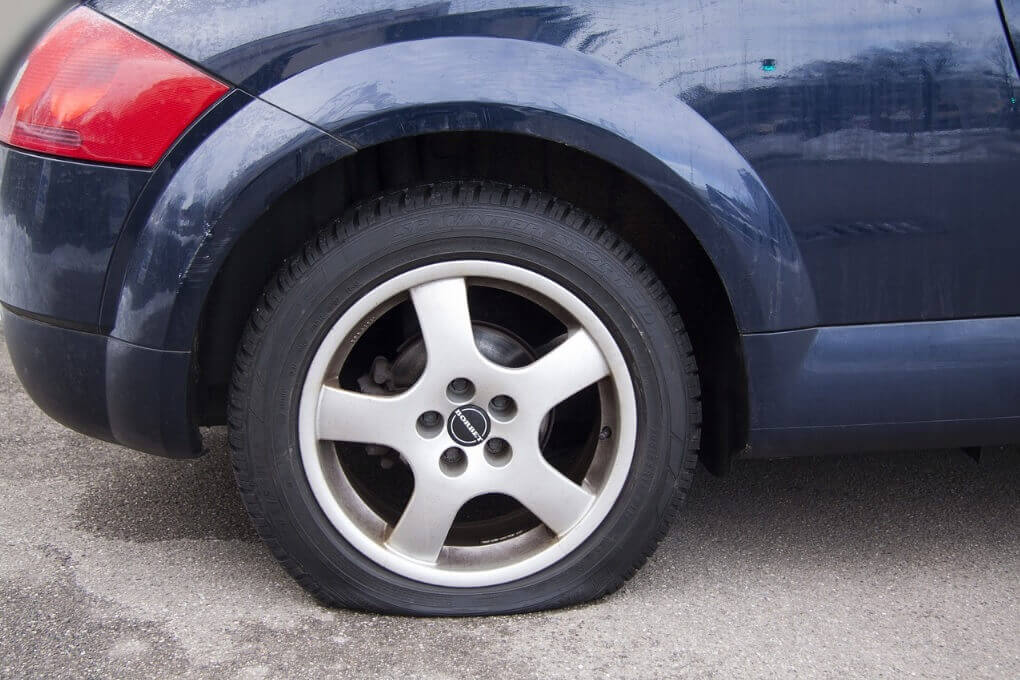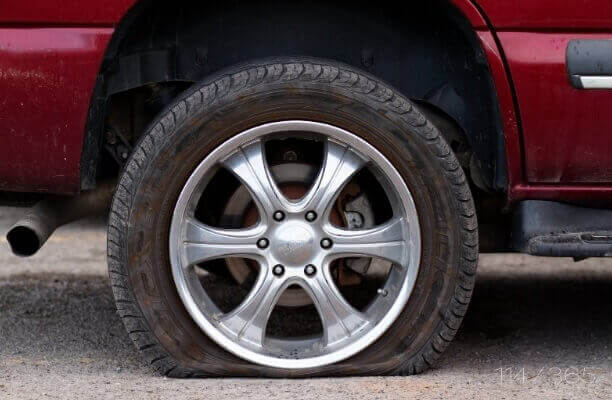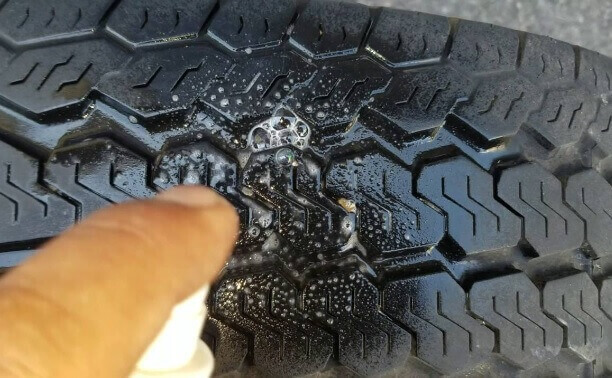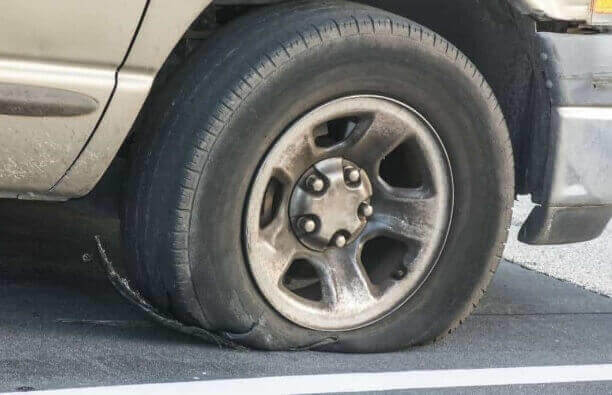Driving on a flat tire is dangerous, but what if it’s an emergency? Can you drive on a flat tire in an emergency? Learn the risks of driving on a flat tire and how to handle the situation safely.
Driving on a flat tire might be the last thing on the planet you want to experience while traveling in your car! The thwarting sound of your tire losing air or falling flat is an awful and dangerous experience you can have!
While some of us check the tires before driving, most car owners/drivers fail to check for any punctures or loose ends on the tires before a drive.
It is highly recommended that you do it because it’s better to be safe than sorry, as they say! However, if your question is – can you drive on a flat tire in an emergency situation? In this case, you need to read this article thoroughly to get the most accurate answer and to learn the do’s and don’ts of driving with a flat tire when there is no other option.

Flat tires may occur for various reasons; sometimes, the starry nail on the road punctures the tire, while sometimes, it is the negligence of the car owner who has not inflated the tire for a long time!
No matter the cause, the question is – Is it safe to drive on a flat tire? Can you drive on a flat tire in an emergency when there is no other option?
Obviously not! Many problems can arise due to a flat tire, which can eventually land you and your car in danger! Not only that, but if you drive with a flat tire, its repair cost may also increase.
Throughout this article, we will discuss all these and more useful information regarding flat tires. So, keep reading to learn everything about driving on flat tires and get valuable tips on tire repair and replacement to ensure safe travels.
Different Types of Flat Tires on Cars:
For many of us who are not so used to seeing flat car tires or know much about car parts, the fact that there are different types of flat tires on cars will shock us! But yes, it’s a fact! The flat car tires we see are of different types that we seldom notice! And when the problem is different, the solution is different too!
So, we need to know what are the different types of flat tires on cars. Let’s check them out:
Slightly Under-Inflated Tire
When driving on a flat tire, you seldom notice the type of issue in the tire. The slightly under-inflated tire is one of the issues you need to notice if you have a flat tire. This happens mostly during seasonal changes when the weather shifts from spring to summer and autumn to winter.

During such a change in temperature, the pressure in the tire also decreases due to the lesser outside influence of the air molecules. If you lack mechanical knowledge, you can check for the under-inflated tire with the naked eye using the following techniques.
- Look at the base of the tires. If any portion is distended or bowed out and looks flabby, it might be a low tire pressure issue.
- You can scroll the menu in modern cars on the car’s center console. Most cars usually tell you about the pressure on all four tires on the screen, which will help you understand whether there is less air pressure on the tires!
- Third, if you notice your car’s fuel mileage has decreased dramatically, then it may also be low pressure that can cause slightly under-inflated tires.
Completely Flat Tire
This is the most common type of flat tire we all notice. A completely flat tire can be easily detected with the naked eye. The tire is completely flabby, if the rim touching the ground in such a condition.

Large punctures or long-term non-inflation are the most common causes of a flat tire.
Leaking Tire
This can be called the precursor step towards a completely flat tire. Any hissing sound coming from the tire could mean it’s leaking. A leaking tire actually means that any object is stuck in the tire that has the potential to cause a big puncture.

Like a nail, pun, screw, debris, or other things that can damage the tire and cause a completely flat tire. Once you diagnose the problem, you must immediately get it off the tire and repair the small puncture.
Blowout Tire
This is the most dangerous kind of flat tire you may experience. The visual of a blowout tire is that the tread does not remain connected to the sidewalls, and of course, it’s completely flat too!

You must immediately pull aside the car once you feel your vehicle is making abrupt noises while running at high speed.
Must check: How Often Should You Check Your Tire Pressure? A Detailed Guide
Can You Drive on a Flat Tire in an Emergency?
The most tempting question that car owners have in their minds is – can I drive a short distance on a flat tire? If you want a straight answer, it is a big NO! Even limping your car to the roadside or the nearby auto mechanic is not suggested by auto experts!
The reason behind a flat tire differs in different situations, and the repair is done accordingly. However, if you drive on the already punctured or flat tire, you may cause more significant harm to it, which will only increase your repair bill.
Not only that, if you insist on driving on a flat tire, you may lead to more problems in the car, including irreparable damage to the brake line, rims, rotors, suspension, steering system, and other essential parts of the vehicle.
So, what perhaps could have been fixed with a bit of inflation or a minor repair would now cost you too many dollars just for those “few seconds” of driving with a flat tire.
Apart from the internal damages, if you are driving on flat tires, you may harm yourself and the passengers seated in your car, as driving with a flat tire means losing control of the vehicle easily, which may cause unexpected accidents on the road.
You may still have the question – can you drive on a flat tire in an emergency situation?
If there is such an emergency where you need to drive with a non-inflated or flat tire, you must be very careful with the speed and distance. The maximum distance on a flat tire is up to 50 miles and maximum speed to drive on a flat tire is not more than 15-20 mph.
But it must be remembered again that when you are confused about what to do when you have a flat tire in the middle of nowhere, and it’s a very emergency situation, only then you should take the risk of driving with a flat tire. Unless this is the case, it is highly recommended that you should not drive with a flat tire!
You might also like: How to Tell Which Tire is Out of Balance (8 Quick Ways)
What Happens If You Drive on a Flat Tire?
By now, you have got the idea that driving with a flat tire isn’t recommended. But in this section, you will understand how bad it is to drive on a flat tire if you wait to pull off the car! Let us discuss this in detail.
It Damages the Rim
So what happens if you drive on a flat tire? First things first! The rim is the first solid layer of the tire that touches the ground whenever there is a flat tire issue. And when it already touches the ground, you must stop your car.
If you keep running the car while the rim touches the ground, it will cause it to get more damaged, so much so that it can get bent or warped. This will require you to buy new rims that will be costlier than just having to repair the flat tire.
Greater Damage to the Vehicle
If you are still wondering how bad it is to drive on a flat tire, you should know it is really bad! Besides damaging your tire and rim, driving with a flat tire can cause a lot of damage to the entire car’s internal parts, including the brakes, suspensions, fenders, rotors, etc.
Not only that, if you keep driving the vehicle for a long time, then it can also damage the car engine and other major parts, which would incur a very high repair cost.
So, the cost that would have been quite little by just repairing the flat tire would now burn your pocket like anything!
Safety Concerns
If you thought the driving on flat tire damage was just warped rims and broken parts of the car, you are too early to judge! There is more damage to the car when you drive with a flat tire than you can imagine. And another such issue is the safety concern of the passenger and driver of the car being driven!
There is a high risk of the car getting displaced and losing control, and when this happens in the middle of the road, it can lead to dangerous accidents that will put the life of the passengers on board at risk!
Unrepairable further damage
Driving on a flat tire will lead to irreparable damage to the car tire that will eventually require an expensive repair or a complete replacement of the tire itself.
If you pull off the car as soon as you feel or experience a flat tire, the repair cost may be much lower compared to the irreparable damage caused to the vehicle when you keep driving with a flat tire!
We hope these two most vital questions (can you drive on a flat tire in an emergency and what happens when you drive with a flat tire) have been clearly answered, and now you know the risk of driving on a flat tire.
Must check: 13 Best Tire Shine That Doesn’t Sling and My #1 Pick Is…
How Far Can You Drive on a Flat Tire?
As discussed above, driving with a flat tire is not recommended. But in an emergency, you may still drive a shorter distance if needed! However, the question here is – how far can you drive on a flat tire when there is no other option?
It is suggested that you only drive for a few miles if there is such a crucial emergency.
The maximum you can go with flat tires is up to 50 miles but that too under certain circumstances of speed and road conditions.
Bad pavement or uneven roads can lead to greater internal and external damage to the car. You may also wonder – how far can you drive on a flat tire without damaging the rim?
Well, the rim is likely to get damaged very quickly if you keep driving with a flat tire. So, even if you are driving a few miles, drive on straight paths and avoid taking sharp turns to avoid pressuring the rims and causing them to get damaged.
While driving on a flat tire is still not suggested, sometimes it becomes the basic need for drivers to do so. In situations where there is no help nearby, and you don’t know how to change flat tires, or you do not have a spare tire, you may have to limp your car to the nearby auto repair shop.
Sometimes, the weather can be too harsh, and you may not take the risk of waiting in your car with a flat tire. So, in all such situations, you may drive a shorter distance but be careful!
To know all the accurate answers to questions such as Can you drive on a flat tire in an emergency and How to handle the situation safely, understanding the maximum speed limit when driving on a flat tire is quite essential. So, let’s jump right to it and find out everything.
You might also like: 13 Best All Terrain Tires for Jeep Wrangler and My #1 Pick Is…
How Fast Can You Drive on a Flat Tire?
We have already discussed in the above section that short distance and slow speed are the keys to driving with a flat tire. You can not have a flat tire and still run your car at 100 MPH or 100 miles, for that matter! It is always about striking the right balance between your car’s speed and the distance you cover with a flat tire.
No wonder we will still mention that driving on flat tires is not at all recommended. But as in an emergency, if you need to drive the car before pulling it aside or get the spare tire to change the flat, then doing it at a minimal speed and shorter distance is suggested!
If you ask what is the right speed limit when driving on a flat tire, then you must know that the right answer is not more than 15-20 mph.
Yes, you read that right; driving your car at a speed of more than 20 mph might not just incur damages to the vehicle itself but also creates safety hazards for you and the passengers sitting inside.
You must also maintain a straight pathway and avoid fast turns, potholes, or other such barriers on the road. So, if you still have the question of how fast can you drive on a flat tire, the answer is 15-20 mph only!
Can You Drive on a Flat Tire When There Is No Other Option?
After reaching this part of the article, you have an idea of what happens when you drive with a flat tire, be it a shorter distance or longer! Throughout the article, we have seen how dangerous it is to have a flat tire and how you must avoid driving with it! However, you can still drive a few miles with a flat tire given the situation is very emergency but that too with some proper guidelines.
No wonder driving with a flat tire is dangerous, and it can cause you greater harm if you try to drive in a flat tire. While most auto experts suggest NOT driving with a flat tire, I would also not recommend driving on a flat tire because of the harm it may bring you and your car.
Moreover, I suggest that anyone reading this article or owning a car or driving one frequently learn to change a flat tire as significantly as you have learned to drive.
Because it is the only way out to deal with a flat tire problem in the middle of the road where getting help or getting a car mechanic is not always possible. And if you know how to change a flat tire with a spare one, you would not have to drive with a flat tire to get to the mechanic which increases the chances of danger.
However, if you still need to drive in an emergency, always maintain the speed limit when driving on a flat tire. Be safe, and be happy!
So, in our expert opinion, the short and straightforward advice to the question, “Can you drive on a flat tire in an emergency situation?” is this; Driving on a flat tire in an emergency is possible but not recommended as it can damage your vehicle and put yourself and others at risk. It’s best to pull over and assess the situation yourself and try calling for help in any way possible.
You may also be interested in checking out:
- 8 Easy and Best Temporary Fix for Broken Car Window
- How to Fix a Cracked Plastic Dashboard (5 Best Methods)
- What is the Best Oil Additive to Stop Engine Knocking?
- How to Make Car Seat More Comfortable for Long Distance Driving